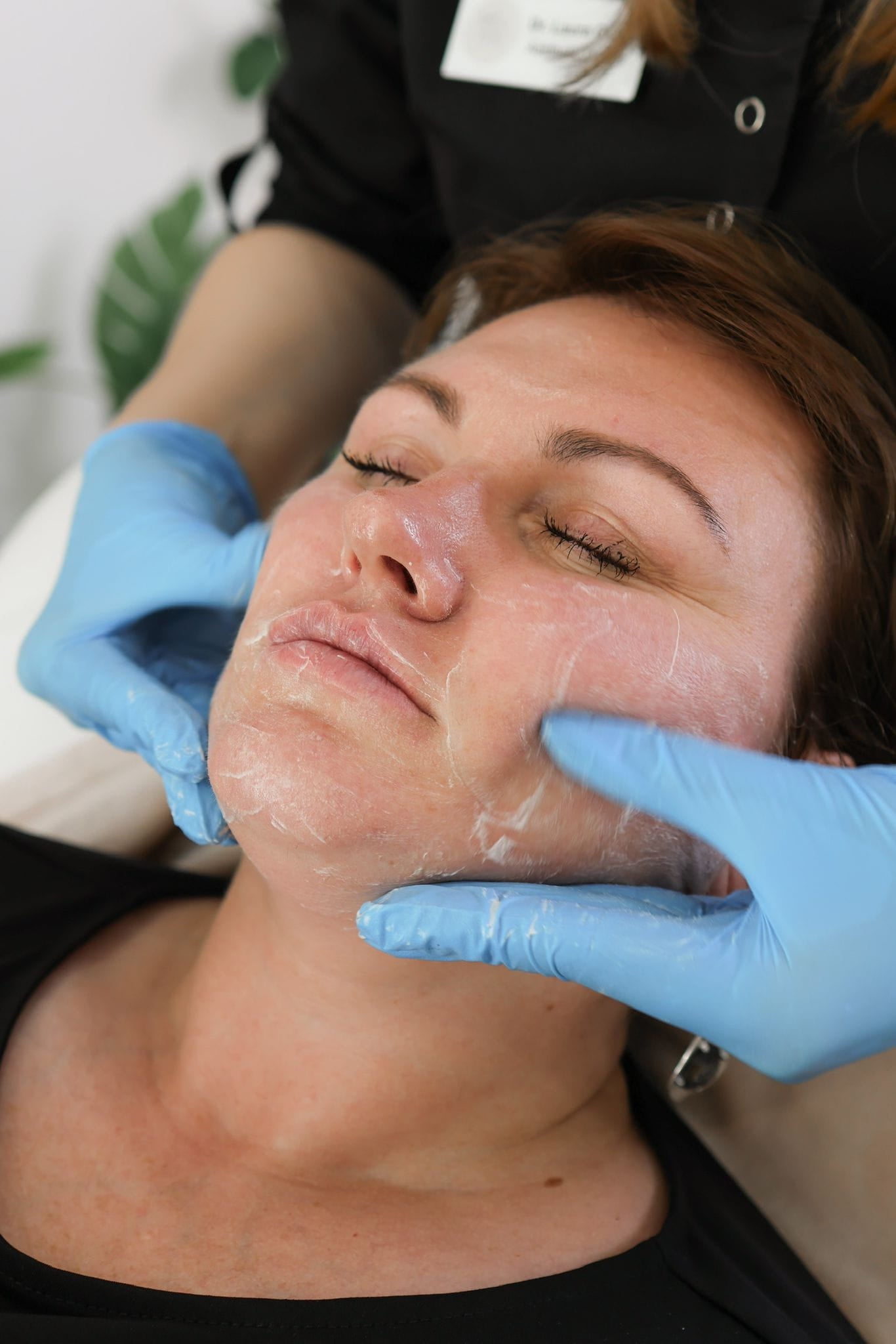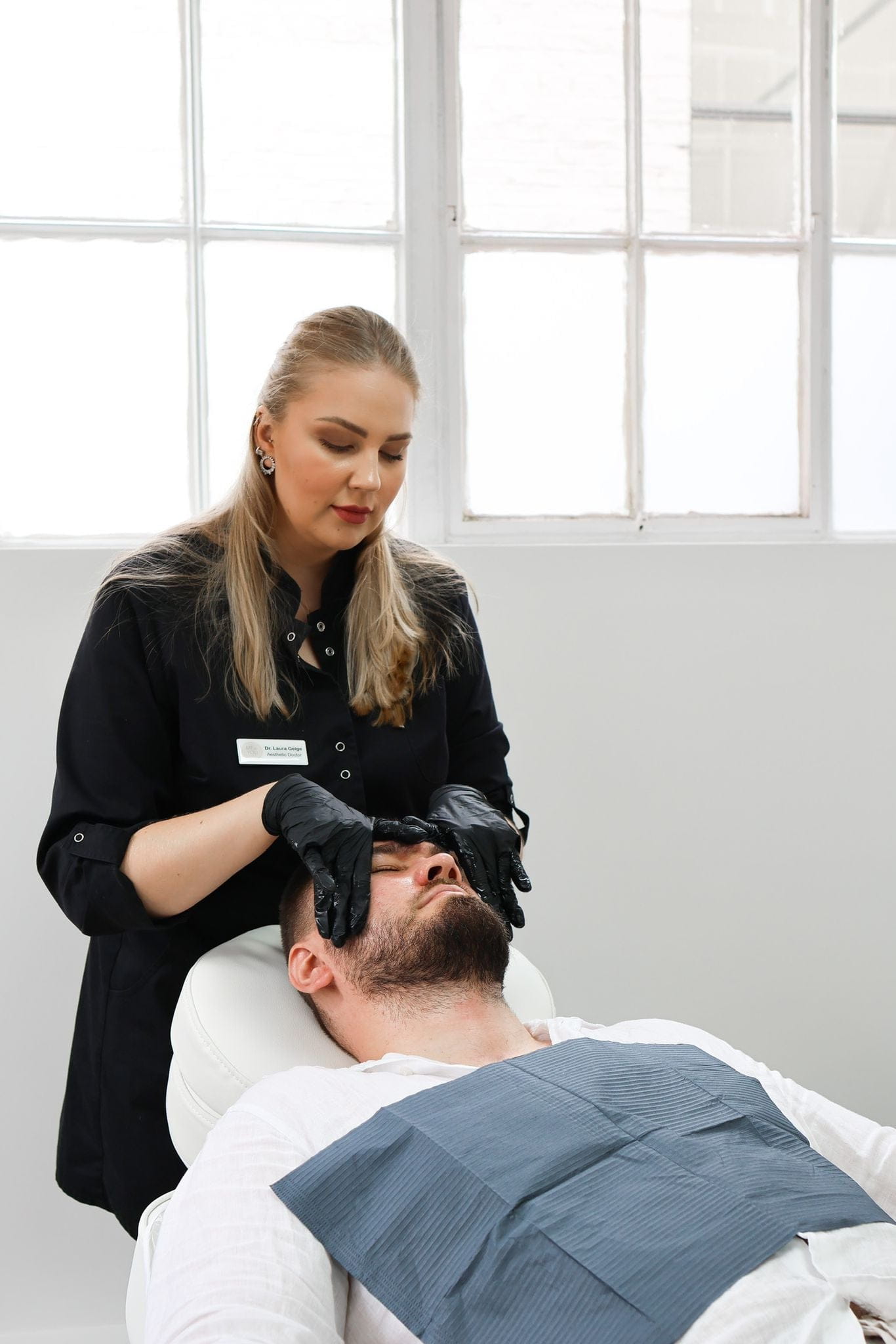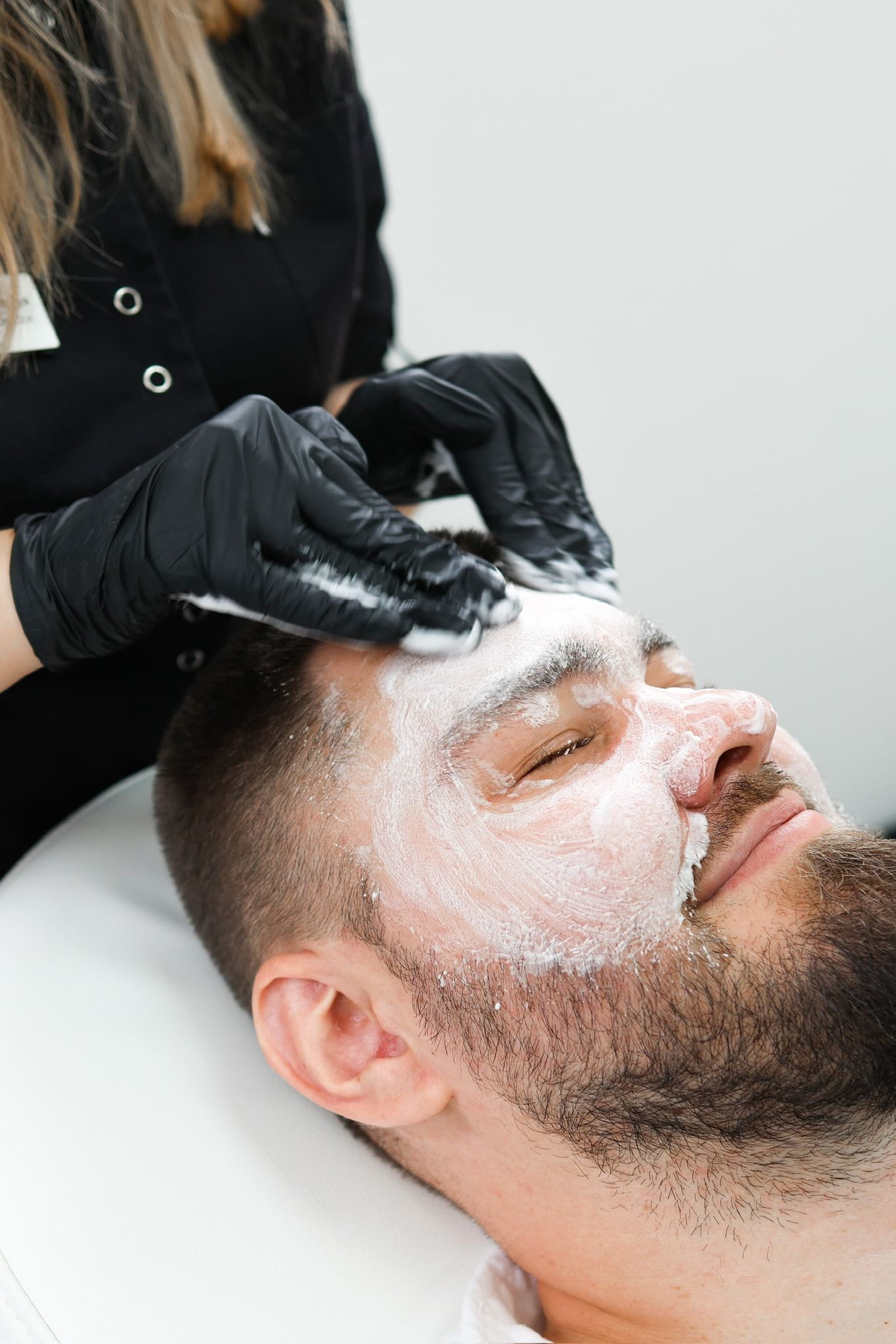Cosmelan Depigmentation Peel
Cosmelan Depigmentation Peel has become increasingly popular in the UK as a solution for tackling stubborn hyperpigmentation. This intensive treatment targets melanin overproduction, aiming to visibly reduce the appearance of dark spots, sun damage, and uneven skin tone.
Mechanism of Action
Cosmelan works by inhibiting tyrosinase, the enzyme responsible for producing melanin, the pigment that gives skin its color. The peel contains a blend of active ingredients, including hydroquinone, kojic acid, and azelaic acid, each contributing to this melanin-reducing effect. Hydroquinone is a powerful inhibitor of tyrosinase, directly suppressing melanin synthesis. Kojic acid also inhibits tyrosinase activity, while simultaneously acting as an antioxidant to protect the skin from further damage. Azelaic acid helps to exfoliate the skin, removing dead cells and promoting cell turnover, revealing brighter, more even-toned skin beneath.
Ingredients
Cosmelan Depigmentation Peel works by inhibiting the production of melanin, the pigment responsible for skin color. It achieves this through a combination of active ingredients.
Hydroquinone is a key ingredient in Cosmelan and acts as a powerful tyrosinase inhibitor. This means it directly reduces the activity of the enzyme that produces melanin, thus decreasing the amount of pigment produced by the skin.
Another important component is kojic acid. Kojic acid also inhibits tyrosinase, working in synergy with hydroquinone to further reduce melanin synthesis. In addition to its depigmenting effect, kojic acid possesses antioxidant properties that protect the skin from further damage caused by free radicals.
Azelaic acid plays a crucial role in exfoliating the skin. It helps remove dead skin cells and promotes cell turnover, revealing brighter, more even-toned skin beneath the surface. This helps to improve the overall appearance of the skin and enhance the effectiveness of the other depigmenting ingredients.
Procedure
Cosmelan Depigmentation Peel is a popular treatment in the UK for hyperpigmentation. It works by targeting melanin overproduction, leading to a reduction in the appearance of dark spots, sun damage, and uneven skin tone.
Here’s how it works:
- The peel contains a blend of active ingredients like hydroquinone, kojic acid, and azelaic acid, each working to reduce melanin production.
- Hydroquinone directly inhibits tyrosinase, the enzyme responsible for melanin synthesis, effectively suppressing pigment production.
- Kojic acid also inhibits tyrosinase and acts as an antioxidant, protecting skin from further damage.
- Azelaic acid exfoliates the skin, removing dead cells and promoting cell turnover to reveal brighter, more even-toned skin beneath.
Benefits
Cosmelan Depigmentation Peel has become increasingly popular in the UK as a solution for tackling stubborn hyperpigmentation. This intensive treatment targets melanin overproduction, aiming to visibly reduce the appearance of dark spots, sun damage, and uneven skin tone.
Here’s how it works:
- The peel contains a blend of active ingredients like hydroquinone, kojic acid, and azelaic acid. Each ingredient plays a specific role in reducing melanin production.
- Hydroquinone directly inhibits tyrosinase, the enzyme responsible for melanin synthesis. This means it effectively suppresses pigment production by blocking the process at its source.
- Kojic acid also inhibits tyrosinase activity, working in synergy with hydroquinone to further reduce melanin synthesis.
- Azelaic acid exfoliates the skin by removing dead skin cells and promoting cell turnover. This helps reveal brighter, more even-toned skin beneath the surface.
Risks and Side Effects
Cosmelan Depigmentation Peel is a powerful treatment that uses a blend of ingredients to reduce melanin production and lighten hyperpigmentation. It’s important to understand the potential risks and side effects associated with this treatment before undergoing it.
Like all chemical peels, Cosmelan can cause temporary skin irritation, redness, and peeling. These side effects are usually mild and subside within a few days to a week.
In some cases, individuals may experience more significant side effects such as sensitivity to sunlight, itching, dryness, or even blistering. It’s crucial to follow the post-treatment instructions provided by your dermatologist carefully to minimize these risks.
A rare but serious risk associated with Cosmelan is ochronosis. This condition occurs when hydroquinone accumulates in the skin, causing a bluish-black discoloration. It’s typically triggered by prolonged and excessive use of hydroquinone products. To minimize this risk, it’s essential to follow your dermatologist’s recommendations regarding the duration and frequency of Cosmelan treatments.

Aftercare Instructions

Cosmelan Depigmentation Peel is a chemical peel that aims to reduce hyperpigmentation by inhibiting melanin production.
After the peel, it’s crucial to follow specific aftercare instructions to ensure optimal healing and minimize potential side effects. Your dermatologist will provide detailed instructions tailored to your individual needs.
Generally, you should avoid direct sun exposure for several weeks following the treatment. Wear sunscreen with a high SPF daily, even on cloudy days, as your skin will be more sensitive to sunlight.
Protect your skin from environmental factors like wind and pollution, which can irritate the treated area.
Avoid using harsh skincare products, scrubs, or exfoliants during the recovery period, as they can damage the delicate skin.
You may experience some peeling or flaking, which is a normal part of the healing process. Avoid picking or scratching your skin, as this can lead to scarring.
Stay hydrated by drinking plenty of water to support cell regeneration and promote healing.
If you notice any unusual symptoms like excessive redness, swelling, pain, or blistering, contact your dermatologist immediately.
Duration and Results
Cosmelan Depigmentation Peel has become increasingly popular in the UK as a solution for tackling stubborn hyperpigmentation. This intensive treatment targets melanin overproduction, aiming to visibly reduce the appearance of dark spots, sun damage, and uneven skin tone.
The peel works by inhibiting tyrosinase, the enzyme responsible for producing melanin, the pigment that gives skin its color. The peel contains a blend of active ingredients, including hydroquinone, kojic acid, and azelaic acid, each contributing to this melanin-reducing effect. Hydroquinone is a powerful inhibitor of tyrosinase, directly suppressing melanin synthesis. Kojic acid also inhibits tyrosinase activity, while simultaneously acting as an antioxidant to protect the skin from further damage. Azelaic acid helps to exfoliate the skin, removing dead cells and promoting cell turnover, revealing brighter, more even-toned skin beneath.
The duration of the results achieved with Cosmelan Depigmentation Peel can vary depending on individual factors such as skin type, severity of hyperpigmentation, and adherence to post-treatment instructions. However, many individuals experience noticeable improvements in their skin tone within a few weeks to months after undergoing the treatment. Maintenance treatments may be necessary to sustain the results over time.
Cost
Cosmelan Depigmentation Peel is a chemical peel designed to reduce hyperpigmentation by inhibiting melanin production. It contains ingredients like hydroquinone, kojic acid, and azelaic acid that work together to target dark spots, sun damage, and uneven skin tone.
The cost of Cosmelan Depigmentation Peel in the UK can vary significantly depending on several factors, including:
the clinic or practitioner you choose
the size of the area being treated
the number of treatments required
on average, expect to pay between £200 and £500 per treatment session.

It’s important to consult with a qualified dermatologist or aesthetic practitioner to get an accurate price quote based on your individual needs.
Consultation and Suitability Assessment
Before undergoing Cosmelan Depigmentation Peel, a consultation with a qualified dermatologist is essential. This consultation allows for a thorough assessment of your skin type, medical history, and specific concerns. The dermatologist will evaluate the extent of your hyperpigmentation and discuss your desired outcomes. They will also explain the treatment process, potential risks and side effects, and provide guidance on aftercare instructions.
Initial Consultation Process
Cosmelan Depigmentation Peel has become increasingly popular in the UK as a solution for tackling stubborn hyperpigmentation. This intensive treatment targets melanin overproduction, aiming to visibly reduce the appearance of dark spots, sun damage, and uneven skin tone.
The process begins with an initial consultation where the dermatologist will assess your skin condition, medical history, and treatment goals. This allows them to determine if Cosmelan is suitable for you and discuss any potential risks or contraindications.
- Skin Evaluation: The dermatologist will examine your skin to assess the type, texture, and severity of hyperpigmentation. They will also consider any existing skin conditions or medications you are taking.
- Medical History Review: A detailed medical history is taken to identify any potential risks or contraindications related to Cosmelan treatment. This includes any allergies, previous skin treatments, or underlying health conditions.
- Treatment Goals Discussion: The dermatologist will discuss your desired outcomes and expectations for the treatment. They will explain what Cosmelan can realistically achieve and manage your expectations.
- Risks and Side Effects Explanation: You will be informed about potential side effects, such as temporary skin irritation, redness, peeling, and sensitivity to sunlight. The dermatologist will also discuss rare but serious risks, like ochronosis, and how to minimize them.
- Aftercare Instructions: Detailed instructions will be provided on how to care for your skin after the treatment to optimize healing and minimize side effects.
Following the initial consultation, if Cosmelan is deemed suitable, the dermatologist will schedule the treatment appointment.
Factors Affecting Suitability
Consultation and suitability assessment are crucial steps before undergoing Cosmelan Depigmentation Peel. Factors that influence a person’s suitability for this treatment include:
Skin Type: Cosmelan is generally more effective on darker skin types as it targets melanin production.
Severity of Hyperpigmentation: The degree and type of hyperpigmentation determine the number of treatments required and the likelihood of achieving desired results.
Medical History: Certain medical conditions, such as eczema, psoriasis, or allergies to ingredients in Cosmelan, may make the treatment unsuitable.
Medications: Some medications can interact with Cosmelan, so it’s essential to disclose all medications you are taking during the consultation.
Sun Exposure: Individuals with a history of excessive sun exposure or sunburns may have more complex hyperpigmentation that requires additional considerations.
Pregnancy and Breastfeeding: Cosmelan is generally not recommended during pregnancy or breastfeeding due to limited research on its safety.
During the consultation, a qualified dermatologist will evaluate these factors and discuss potential risks, benefits, and realistic outcomes for your individual case.
- How Skincare Consultations Help With Managing Fine Lines And Wrinkles - August 29, 2025
- How Safe Is A Retinol Peel In Kingston Upon Thames - August 26, 2025
- How Much Is 1 Ml Of Lip Filler - August 23, 2025

